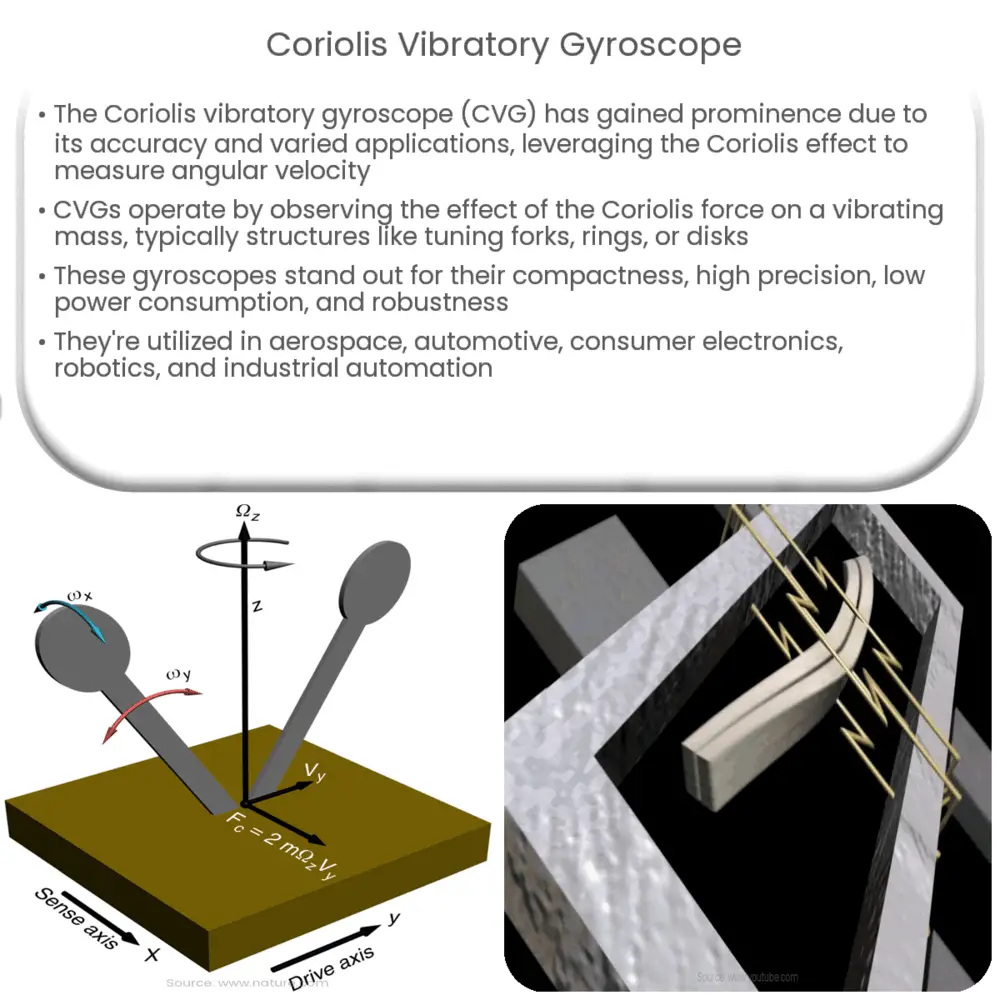The Coriolis Vibratory Gyroscope is a compact, accurate motion sensor that measures angular velocity using the Coriolis effect, ideal for various industries.

Coriolis Vibratory Gyroscope: An Overview
Introduction
The Coriolis vibratory gyroscope (CVG) is a type of gyroscope that has gained significant attention in recent years due to its impressive accuracy, sensitivity, and wide range of applications. This compact and lightweight device relies on the Coriolis effect to measure angular velocity, making it an ideal choice for many industries, including aerospace, automotive, and consumer electronics. In this article, we will provide an overview of the CVG, discussing its basic principles, various designs, and key advantages.
Basic Principles of the Coriolis Vibratory Gyroscope
The CVG operates on the principle of the Coriolis effect, a phenomenon that occurs when a mass moves within a rotating frame of reference. The Coriolis force, which is perpendicular to both the object’s velocity and the axis of rotation, causes the object to experience an apparent deflection in its trajectory. In a CVG, the rotation rate is determined by measuring this force as it affects a vibrating mass.
Typically, a CVG consists of a resonating structure that is set into motion, such as a tuning fork, a ring, or a vibrating disk. When the gyroscope is stationary, the vibrating structure oscillates symmetrically about its equilibrium position. However, when the gyroscope rotates, the Coriolis force acts on the vibrating structure, causing it to exhibit an additional secondary motion, which is proportional to the rotation rate. By measuring the amplitude of this secondary motion, the angular velocity of the gyroscope can be determined.
Various CVG Designs
Over the years, researchers and engineers have developed numerous CVG designs, each with its unique advantages and disadvantages. Some of the most common designs include:
- Tuning Fork Gyroscope: In this design, a pair of masses is connected by a flexible beam, forming a structure similar to a tuning fork. When the structure vibrates, the masses oscillate in opposite directions. If the gyroscope rotates, the Coriolis force causes the masses to exhibit a secondary motion, which is measured to determine the rotation rate.
- Vibrating Ring Gyroscope: This design features a thin, circular structure that vibrates in a radial mode. When subjected to rotation, the Coriolis force induces an additional secondary motion in the ring, which is measured to determine the angular velocity. Vibrating ring gyroscopes are known for their high sensitivity and low noise levels.
- Vibrating Disk Gyroscope: In this design, a flat, circular structure is set into motion, oscillating in a bending mode. When the gyroscope rotates, the Coriolis force induces a secondary motion in the disk, which is measured to determine the rotation rate. Vibrating disk gyroscopes offer advantages such as high accuracy and low drift.
Key Advantages of CVGs
Coriolis vibratory gyroscopes offer several advantages over other types of gyroscopes, such as mechanical and optical gyroscopes. Some of the key benefits include:
- Compact and lightweight: CVGs are often smaller and lighter than their counterparts, making them ideal for applications with stringent size and weight constraints.
- High accuracy and sensitivity: CVGs can detect small changes in angular velocity, providing high-resolution measurements that are essential for precise navigation and control applications.
- Low power consumption: CVGs generally consume less power than other types of gyroscopes, making them a suitable choice for battery-powered devices and energy-efficient systems.
- Robustness and reliability: CVGs have no moving parts, which reduces wear and tear and improves their overall reliability. Additionally, they are less susceptible to environmental factors such as temperature, pressure, and shock, ensuring stable performance in a variety of conditions.
- Cost-effectiveness: Due to their simple construction and the use of microelectromechanical systems (MEMS) technology, CVGs can be produced at a relatively low cost, making them an attractive option for a wide range of applications.
<
Applications of Coriolis Vibratory Gyroscopes
CVGs are used in various industries and applications, including:
- Aerospace and Defense: CVGs play a crucial role in navigation, stabilization, and guidance systems for aircraft, missiles, satellites, and unmanned aerial vehicles (UAVs).
- Automotive: CVGs are used in electronic stability control (ESC) systems to enhance vehicle safety and performance, as well as in advanced driver-assistance systems (ADAS) to enable features such as lane departure warnings and autonomous driving.
- Consumer Electronics: CVGs can be found in smartphones, tablets, and gaming consoles, where they provide motion sensing and control for a more immersive user experience.
- Robotics: CVGs are used in robotic systems for navigation, stabilization, and control, ensuring precise movement and accurate positioning.
- Industrial Automation: CVGs are employed in manufacturing and process control systems to improve the accuracy and efficiency of various operations, such as assembly, inspection, and material handling.
Conclusion
Coriolis vibratory gyroscopes have emerged as a promising technology in the field of motion sensing and control, offering numerous advantages over traditional gyroscopes. With their compact size, high accuracy, and robust performance, CVGs are well-suited for a wide range of applications in various industries. As technology continues to advance, it is expected that CVGs will play an increasingly important role in the development of innovative solutions and systems that rely on precise motion sensing and control.

